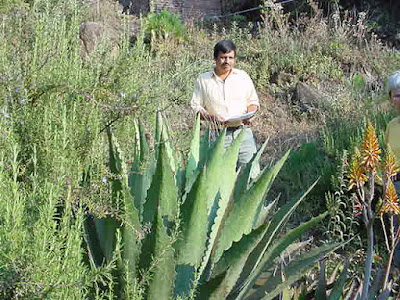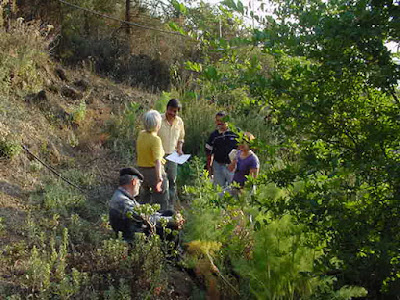Three of us made the drive to Angangueo today with the intent of seeing Monarch butterflies at Sierra Chincua. (It was about 148 miles from Patzcuaro's La Estacion area to Sierra Chincua.)
Everything worked fine, especially the new highway that's nearly finished between Maravatio and Irimbo. That is, until we arrived in downtown Ang .... there we ran into lots of soldiers and local police. My friends who are visiting from Seattle were a little taken aback by so many soldiers in combat gear and I, too, thought it a bit odd. At the top of the hill, we saw a military helicopter flying overhead and were stopped by three police/military patrols. And, the road into Sierra Chincua was barricaded. Now this was definitely leaving us with an uncomfortable feeling.
For whatever reason, the officials at the turnoff into the reserve let us proceed; however, at the gate where one normally pays an entrance fee, we were told we couldn't go further. Sensing our befuddlement, that's when someone probably broke all security rules: He told us President Calderone was participating in a special event and we couldn't enter the reserve until 1 PM. So we had to figure out something to do for nearly 3 hours. Thankfully today was market day in town, and we were sated with delicious freshly made blue corn tortillas filled with a combination of bifsteak, beans, cheese, and great salsa. (Are you reading this Don y Dona Las Cuevas??......you would love them and at 7 pesos, the price couldn't be beat!)
At 12:45 we headed back to Sierra Chincua, where we had to wait at the entrance. Maybe 10 minutes later, the President's caravan of vehicles exited and we were allowed into the reserve. Well, lo and behold, the ratty structures of the past are gone, and today's event was the inauguration of several new buildings for little restaurants, trinket shops, new bathrooms with American standard toilets, and a huge salon for educational purposes.
We were unable to find Don Pancho, an elder of the ejido who has guided me to the butterflies in the past. Instead, we met Noe Valdez who agreed to leave the festivities to guide us to the nearest colony. Imagine my surprise to learn that he's participating in a certificate program to be a bird guide. Perfecto. Although Noe doesn't speak English, he spoke slow enough that I could understand nearly all of his Spanish. The weather was lovely - not cold or windy. Our walk to the colony took us through patches of green meadow and through oyamel-pine forest. The trail was well groomed and was a gentle climb, not the grunt I've done twice at Rosario. Be that as it may, our hearts were beating and we were somewhat out of breath. Brief stops along the way allowed us to rest. New interpretive signs provide important information about the butterflies, in Spanish and English.
When we arrived at the colony (30-40 minutes), we had an amazing experience. We were alone with trees full of butterflies. Noe showed my friends how to sex the butterflies. We were very close to the butterflies; they were flying all around and momentarily landing on us. Because no one else was in the vicinity, we could hear the butterflies' wing-flapping. This was truly a mystical time with Mother Nature.
While some individuals recommend that the best time to visit the reserve is in January or February when many more butterflies are present, I maintain that it's worthwhile to visit early in the season when hordes of visitors are not there. Soon the area will be roped off and whispering is mandated. It's dustier and hawkers are assertive. Visiting a Monarch butterfly sanctuary is a must-see thing to do. I just wanted everyone to have another perspective.
I definitely recommend Noe or Don Pancho as local guides. I doubt you could do better.
From the Yahoo group - Michoacan Net













